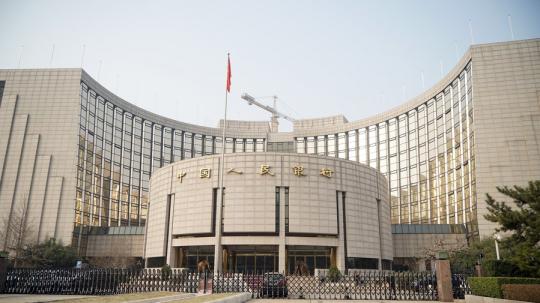
File photo shows the headquarters of the People's Bank of China in Beijing. (Photo/Xinhua)
Hopes of monetary policy easing stir debate on credit, consumer demand
Financial institutions should maintain a positive attitude in bolstering the real economy as China will further ease its monetary policy this year to ensure an uptick in the overall economy, experts said.
Major banks should maintain credit support for the real economy and promote an economic upturn, according to decisions made at a meeting held by China's central bank and the top banking and insurance regulator on Tuesday.
Some credit extension procedures and some credit policies need to be adjusted according to different situations in different cities and regions. The standards and requirements for risk identification should be relaxed at financial institutions, which may have a higher risk appetite, said Lian Ping, chief economist at Zhixin Investment and head of the Zhixin Investment Research Institute.
The People's Bank of China, the central bank, should extend more loans to commercial banks via relending facilities with a focus on major areas of the economy. Such low-cost funds will allow commercial banks to better support the real economy and boost consumer demand, Lian said.
In addition, the PBOC may cut the reserve requirement ratio once or twice this year by 25 basis points each and lower its market-based benchmark lending rates two or three times by 20 to 40 basis points in all for the whole year, he said.
China's new yuan-denominated loans totaled 1.4 trillion yuan ($206.74 billion) in December, up by 266.5 billion yuan year-on-year. However, its increment in aggregate social financing — the total amount of financing to the real economy — came in at 1.31 trillion yuan last month, down by 1.05 trillion yuan compared with the same period of previous year, the PBOC said.
The country's new yuan-denominated loans hit 21.31 trillion yuan in 2022, up by 1.36 trillion yuan from 2021. The steady growth in lending has helped stabilize economic fundamentals, experts said.
In 2023, China's new yuan-denominated loans and increment in aggregate social financing are expected to grow more rapidly than in the previous year, said Lou Feipeng, senior economist at Postal Savings Bank of China.
The structural monetary policy will play an important role in guiding the flow of funds. Apart from bolstering the firm demand for housing, China may also launch policies to support the demand for upgraded housing according to market conditions and guide corporate loans to key areas of the economy, including privately owned small businesses, technological innovation and the manufacturing sector, Lou said.
In the first half of this year, the PBOC is likely to further cut the interest rates of its medium-term lending facility loans, which will lead to the lowering of loan prime rates, market-based benchmark lending rates, especially the five-year LPR, he said.
Zeng Gang, director of the Shanghai Institution for Finance &Development, said boosting domestic demand is a major task for China this year, which requires targeted and strong structural monetary and financial policies to support the private sector, platform enterprises and small businesses, with the aim of creating more jobs and increasing household incomes.
Policies should also be launched to strengthen support for major areas of the real economy, such as the demand for upgraded housing, new energy vehicles, elder care, infrastructure investment, industrial modernization, low-carbon development and rural vitalization, he said.
China International Capital Corp, a joint-venture investment bank, raised its GDP growth forecast for China on Wednesday to about 5.5 percent this year in a base-case scenario from around 5.2 percent expected in November. The World Bank on Tuesday slashed its 2023 projections for global economic growth to 1.7 percent in 2023 from 3 percent expected six months ago.


